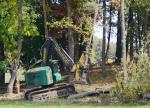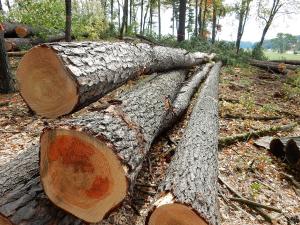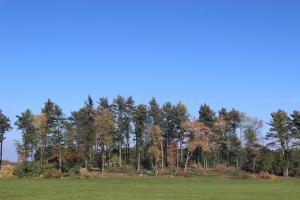Forestry on Historic Plantations
Unfortunately, these plantations haven’t aged well. The trees haven't been regularly thinned, so they've had no elbow room to grow. This has made them vulnerable to disease and yielded small crowns (tree tops). The understory is thick with nonnative shrubs of buckthorn, honeysuckle and bittersweet. It all means that the original conifers are not reseeding, though many other tree species have. These significant landscape features need help!
So we’ve started reclaiming them. Gradually.
As with all land management decisions (any decision, really), our forestry is a balancing act to meet multiple goals.
We manage our Green Certified woodlands for wildlife habitat and ecosystem health, lumber and firewood, and for education and public enjoyment. With our plantations, the integrity of the historic Olmsted landscape enters the mix. It’s a tall order.
How did this all play out on these plantations? Well, the white pines that we left around the edges will help preserve the dark green look of the historic plantation, consistent with our Historic Landscape Management Plan.
At the same time, we left many saplings of red, white, and bur oak, hickory, black cherry, and more: a conscious effort to increase diversity. These are all species common in the Champlain Valley. And this summer, the visiting Forest Guild confirmed with us that diversity = increased resilience in the face of climate change.
As these young trees grow and need more light, we’ll harvest the mature pine and black cherry trees for lumber.
Invasive shrubs are a particularly “thorny” problem. Buckthorn compromise ecological systems, biological diversity, and forest economies across Vermont and beyond. Over the last decade, we’ve tried various mechanical methods to control them (complete eradication may be too optimistic). We’ve pulled out shrubs by the roots with tractors and tools, and this year, cut them back with the feller/buncher. We’ve even let our cows graze in one plantation to help keep invasives in check. (It works!)
The techniques are costly though. They require vigilance and repeat treatments. Buckthorn reseeds quickly after birds and creatures eat – then excrete – the berries.
Thinning the two plantations yielded a lot of lumber. Ten log truck loads of white pine (about 60,000 board feet) were sold to a local sawmill, and we kept about 8,000 board feet. Much of it will go into a new sugar house that we're fundraising to build next year. Twelve tractor trailer loads of chipped wood were hauled to the McNeil Electrical Generating Station in Burlington.
The thinned plantations will take a few years before they look "whole" again, but in forestry, as with many things, you have to take the long view. And with 51 different plantations, ranging in size from ½-acre to 8 acres, we're definitely taking the long view! The process of reclaiming them all will take years, but we’re digging in, taking stock, and adapting to what we observe over time, always balancing multiple objectives.
PS: If you’re interested in some farm lumber, we’re currently selling a wide variety of hardwood and softwood. Contact Dana Bishop or Marshall Webb for prices and information.




